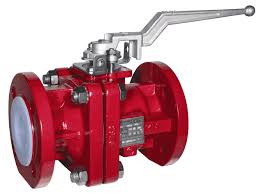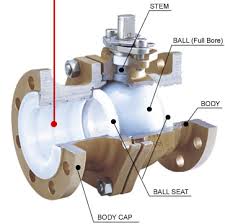Lined Valves

The Application of Lined Valves
Introducing Cameron’s innovative range of lined valves, designed for diverse applications in industries such as oil and gas, petrochemicals, and power generation. Our portfolio includes versatile solutions like the in-line check valve, fuel line shut-off valve, and in-line fuel check valve. Engineered with precision and reliability in mind, Cameron’s lined valves feature durable linings that resist corrosion and abrasion, ensuring long-term performance and integrity. Whether it’s maintaining fluid flow direction with the in-line check valve or providing safety and control in fuel systems with shut-off valves, Cameron’s lined valves offer unmatched reliability and efficiency. Trust Cameron for superior solutions that meet your most demanding requirements.
What Are The Types Of Lined Valves?
- Lined Ball Valves: These valves use a spherical closure element to control flow. They are suitable for applications requiring tight shut-off and precise control.
- Lined Butterfly Valves: Butterfly valves use a disc mounted on a rotating shaft to control flow. They offer quick operation and are suitable for large flow applications.
- Lined Check Valves: Check valves allow flow in one direction while preventing backflow. They are essential for preventing reverse flow and protecting equipment.
- Lined Globe Valves: Globe valves have a globe-shaped body with a movable disk to regulate flow. They offer precise control and are commonly used in throttling applications.
- Lined Diaphragm Valves: Diaphragm valves use a flexible diaphragm to regulate flow. They are ideal for handling corrosive or abrasive fluids.
What Is Lined Valves?
Lined valves are specially designed valves with an inner lining made of corrosion-resistant materials such as PTFE (Polytetrafluoroethylene) or PFA (Perfluoroalkoxy). This lining protects the valve from corrosive fluids and abrasive media, ensuring longevity and reliability in demanding industrial applications. Lined valves are commonly used in industries such as chemical processing, oil and gas, and wastewater treatment, where resistance to corrosion and erosion is crucial for operational efficiency and safety.
How to Select the Right Lined Valves?
Selecting the right lined valves involves considering factors such as the type of fluid, temperature, pressure, and chemical compatibility. Evaluate the specific requirements of the application and choose valves with appropriate lining materials and construction to ensure resistance to corrosion and erosion. Consider the valve type, size, and configuration to meet operational needs effectively. Prioritize features such as durability, reliability, and compatibility with existing systems to ensure optimal performance and longevity.
Features of Lined Valves
- Fluid Compatibility:
- Consider the type of fluid the valve will be in contact with and ensure that the lined valve is compatible with it to prevent corrosion or damage.
- Temperature Range:
- Evaluate the operating temperature range of the application and choose a lined valve with a lining material that can withstand the temperature extremes without degradation.
- Pressure Rating:
- Determine the maximum pressure the valve will be exposed to and select a lined valve with a pressure rating that exceeds this requirement to ensure safety and reliability.
- Lining Material:
- Choose a suitable lining material such as PTFE or PFA based on the chemical compatibility and temperature requirements of the application.
- Valve Type:
- Select the appropriate valve type (e.g., ball valve, butterfly valve, check valve) based on the specific function and flow control needs of the application.
- Size and Connection Type:
- Determine the required valve size and connection type (e.g., flanged, threaded) to ensure compatibility with the piping system and installation requirements.
Advantages and Disadvantages of Lined Valves
Advantages:
- Corrosion Resistance: Lined valves offer excellent corrosion resistance, making them suitable for handling corrosive fluids and chemicals.
- Abrasion Resistance: The inner lining protects the valve from abrasion, extending its lifespan and reducing maintenance needs.
- Chemical Compatibility: Lined valves are compatible with a wide range of chemicals, ensuring versatility and reliability in various applications.
- Smooth Flow: The smooth surface of the lining minimizes friction and turbulence, allowing for efficient fluid flow and reduced pressure drop.
Disadvantages:
- Cost: Lined valves can be more expensive than standard valves due to the additional lining material and manufacturing processes involved.
- Temperature Limitations: Some lining materials have temperature limitations, which may restrict their use in high-temperature applications.
- Installation Complexity: Special care is required during installation to prevent damage to the lining, increasing installation complexity and potential costs.
- Maintenance Requirements: Lined valves may require more frequent inspection and maintenance to ensure the integrity of the lining and prevent damage or degradation.

The Specifications of Lined Valves
| Specification | Details |
|---|---|
| Type | Ball Valve |
| Ball Material | Stainless Steel with PTFE Lining |
| Attachment Type | Flanged, Threaded, Welded |
| Thread Standard | ANSI B16.5, DIN, BS, JIS |
| Thread Size | 1/2 inch – 8 inches |
| Body Material | Carbon Steel with PTFE Lining |
| Safe for Use With | Corrosive Fluids, Chemicals, Abrasive Media |
| Handle Type | Lever, Gear, Actuated |
| Handle Material | Carbon Steel, Stainless Steel |
| Maximum Working Pressure (psi) | Up to 1500 psi |
| Maximum Working Pressure (bar) | Up to 103.42 bar |
| Operating Pressure | 0 psi – Maximum Working Pressure |
The Installation Steps for Lined Valves
- Preparation:
- Gather all necessary tools and equipment, including wrenches, gaskets, and pipe thread sealant.
- Ensure the work area is clean, dry, and free from debris.
- Valve Selection:
- Choose the appropriate lined valve type, size, and configuration for the specific application and system requirements.
- Valve Positioning:
- Identify the ideal location for the valve in the piping system, considering accessibility and operational requirements.
- Valve Mounting:
- Securely mount the lined valve to the pipeline using appropriate bolts and gaskets.
- Ensure proper alignment of the valve to facilitate smooth operation.
- Attachment Connection:
- Connect the lined valve to the piping system using flanged, threaded, or welded connections, depending on the valve design and system requirements.
- Apply pipe thread sealant or gaskets to ensure a secure seal.
- Actuator Installation:
- If the lined valve includes an actuator, install it according to the manufacturer’s instructions.
- Connect any necessary wiring or tubing for actuation and control.
- Pressure Testing:
- Conduct a pressure test on the valve and piping system to ensure there are no leaks or defects.
- Follow industry-standard procedures for pressure testing, including gradually increasing pressure and monitoring for leaks.
- Final Inspection:
- Inspect the installed lined valve for proper alignment, tightness of connections, and overall functionality.
- Verify that all components are installed correctly and securely.
- Documentation:
- Maintain detailed records of the installation process, including valve specifications, pressure test results, and any adjustments made during installation.
- Update system documentation and diagrams to reflect the newly installed lined valve.
- Training:
- Provide training to relevant personnel on the operation, maintenance, and troubleshooting of the lined valve system.
The Operation Theory of Lined Valves
- Check Valve in Fuel Line: This valve allows fluid to flow in only one direction, preventing backflow in the fuel line. When the fluid flows in the desired direction, the valve opens, allowing passage. However, if there’s reverse flow or pressure drop, the valve closes, preventing fuel from flowing backward.
- Fuel Line Valve Shut Off: This valve is designed to completely stop the flow of fuel in the line. It functions by closing off the passage when activated, typically through manual or automatic mechanisms. This shutdown prevents the flow of fuel in emergency situations or during maintenance activities.
The Parameters Chart of Lined Valves
| Parameter | Material |
|---|---|
| Valve Type | Ball Valve, Butterfly Valve, Check Valve, etc. |
| Valve Body Material | Carbon Steel, Stainless Steel, Cast Iron, etc. |
| Lining Material | PTFE (Polytetrafluoroethylene), PFA (Perfluoroalkoxy), FEP (Fluorinated Ethylene Propylene), PVDF (Polyvinylidene Fluoride), etc. |
| Seat Material | PTFE, PFA, FEP, PVDF, Metal (Stainless Steel, Hastelloy, etc.) |
| Stem Material | Stainless Steel, Carbon Steel, Alloy Steel, etc. |
| Connection Type | Flanged, Threaded, Welded, Socket Weld, etc. |
| Actuator Type | Manual, Electric, Pneumatic, Hydraulic, etc. |
| Maximum Working Pressure | Depends on valve type, lining material, and size. |
| Maximum Temperature | Depends on lining material and valve design. |

